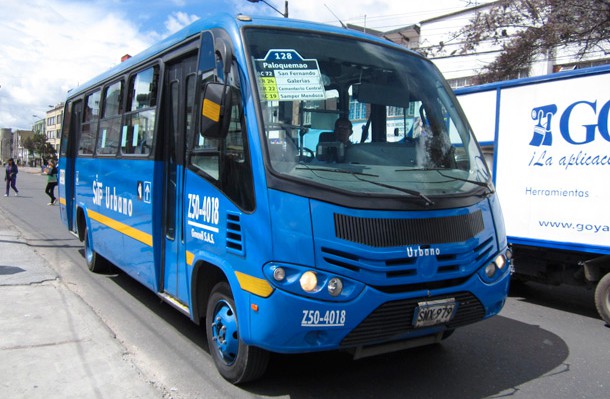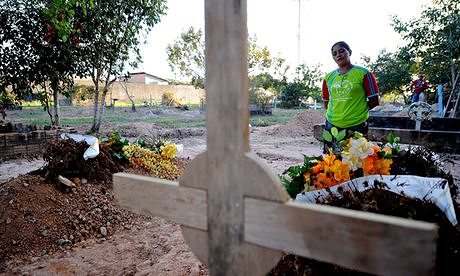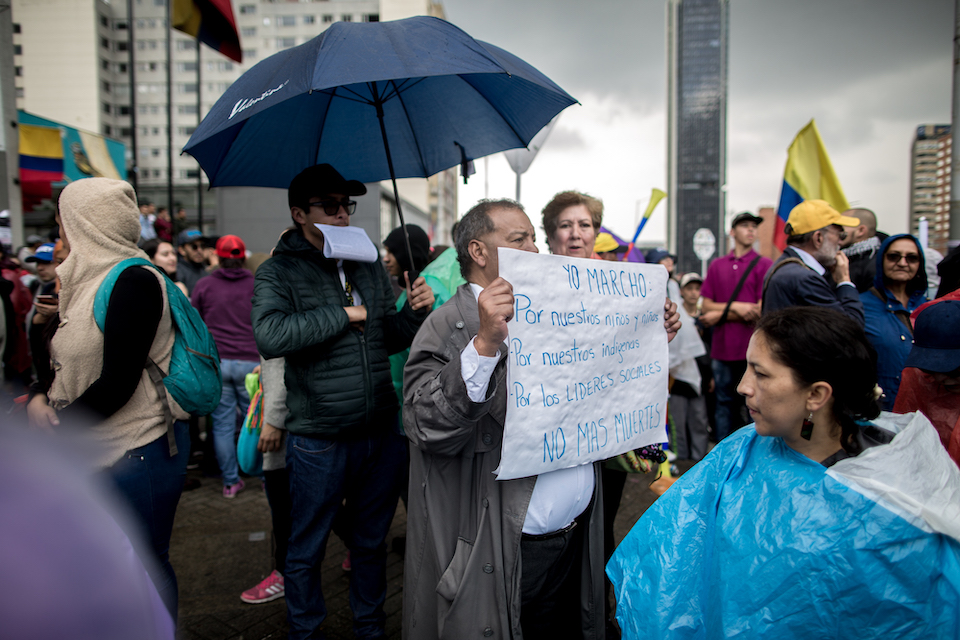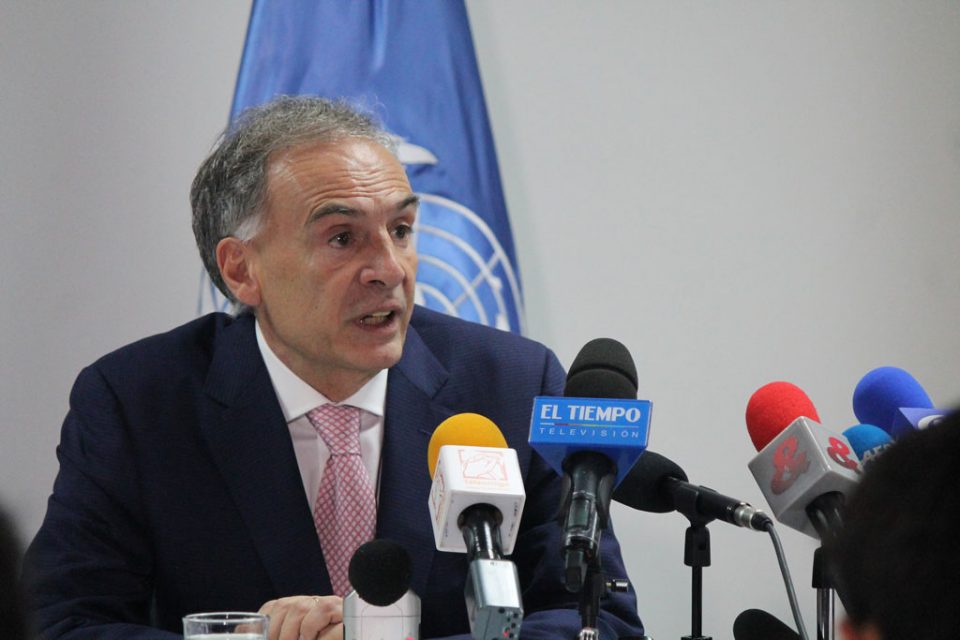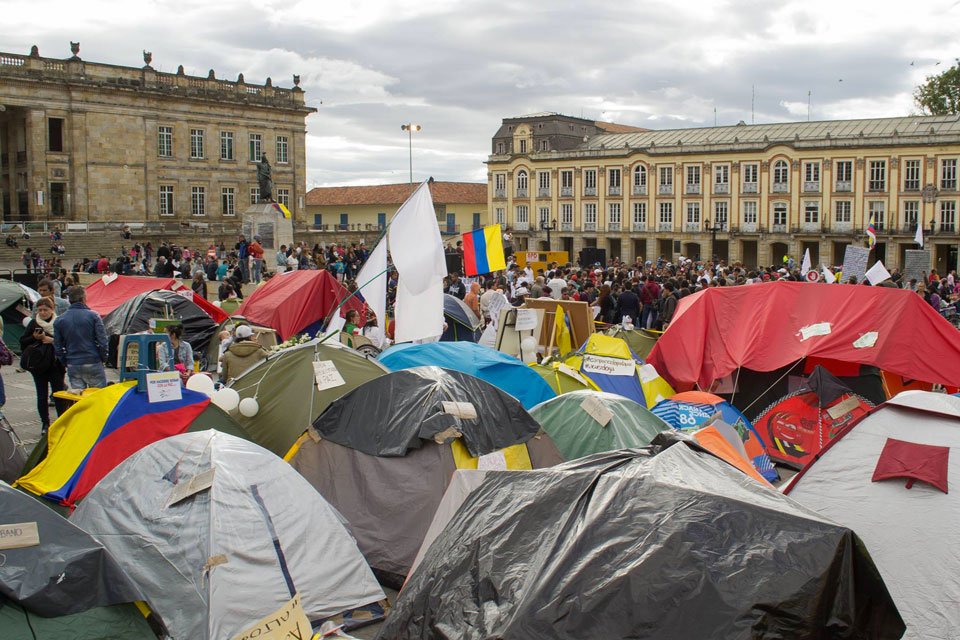
The tented village which was recently torn down in Plaza Bolívar. Photo: Paz a la Calle
As ‘Yes’ and ‘No’ protesters take to the streets, Rocio Labrador speaks to campaigners on both sides.
There have been huge demonstrations up and down the country this year, as hundreds of thousands of Colombians took to the streets to either support or oppose the peace agreement with the FARC. The demonstrations from protesters on both sides of the fence are unlikely to stop following the November 12 announcement of a new, modified accord, even in the face of efforts by the police to quell civil unrest.
Immediately after the plebiscite, pro-peace agreement campaigners set up camp in Plaza Bolívar, committing to maintain their presence outside the government buildings until the country was at peace.
However, in the early hours of November 19, police purportedly forced the protesters to dismantle their campamento por la paz, where they had been stationed for 49 days. According to campsite resident Juliana Bohórquez, riot police used batons to force protesters into packing their tents and vacating the plaza.
The expulsion of protesters from Plaza Bolivar was carried out on the basis that – in light of the new accord – the camp had achieved its goals. This interpretation betrays a fundamental misunderstanding of the driving force behind the popular protests, as I found out when I visited the camp to talk to the people there.
‘No’
The serious demonstrations against the peace agreement began in April, when senator Álvaro Uribe mobilised civilian demonstrations in 22 cities throughout the country.
“A badly crafted peace can dissolve into war,” Carlos Ossa, a lawyer who acted as chief coordinator and keynote speaker at the Bogotá protests told me. “Even if the plebiscite had won, we would not be a country at peace.”
Those who objected to the peace agreement raised a number of concerns and criticisms, many of which have been at least partially addressed in the modified agreement signed on November 12. But there is still a high level of dissatisfaction and political resistance to the new agreement is all but inevitable.
“There are many good things about the new agreement,” claimed Ossa. “But what truly disillusions me is that guerilla members convicted of human rights violations are still allowed to participate in the political process. I consider it an incomplete accord.”
‘Sí’
Pro-peace deal protests reached their peak on October 5 when thousands marched in Bogotá, Barranquilla, Bucaramanga, Cali, Cartagena and Santa Marta with placards reading ‘¡Acuerdo Ya!’, demanding an immediate agreement. In the capital, the silent march culminated in Plaza Bolívar, where four university students established the campamento por la paz – camp for peace.
Until they were moved on, the sea of tents – temporary home to about 300 Colombians and 14 foreigners – occupied the Plaza Bolívar, right in front of the Colombian Congress, the Palace of Justice and the mayor’s offices. Its occupants had settled in for the long haul, creating living spaces, meeting rooms and a cooking area. A whiteboard on the wall listed the day’s groceries and divvying of chores. Graffiti on the 90 tents and makeshift tin walls read “For all the victims: treaty now!” and “We aren’t the least bit afraid. Welcome to the fight.”
The Camp for Peace became an end point for demonstrations by ‘Yes’ campaigners, who marched to the campsite three times, demanding swift government action.
“In our manifesto we’ve identified two main objectives: that the government achieve a peace treaty now, and that there be a definitive bilateral ceasefire,” said Alexander Cardona, chief of security at the campsite and a career human rights activist when I spoke to him just days before the camp was dismantled. The same manifesto binds the sister campsites erected in the main squares of nine cities across the country, including Medellín, Villavicencio and Putumayo.
The manifesto, however, is only the first part of an ideological roadmap. Campaigners want to ensure that the peace agreement is properly implemented. A particular concern is that the government ensure the safety of former guerrilla members as they reintegrate into society so as to avoid a repeat of the deaths of roughly 4,000 members of the partially demobilised guerrilla party Union Patriótica in the late 80s at the hands of paramilitary groups.
In addition to holding the government and the FARC accountable for the implementation of the peace agreement, the activists are pushing for substantial progressive social reforms.
“The agreement is a reference point,” stated Cardona, “but we need to find real, effective and definitive solutions to other issues before there is any social justice and a lasting peace.”
According to these campaigners, requirements that must be met in order to achieve social justice include free education, free healthcare, tax reforms, a comprehensive program for the reintegration of victims, an end to impunity, and the elimination of corruption in Colombia. In addition, the number of Congressmen who have longstanding ties to the social elite must be reduced.
“The new agreement does not meet the characteristics or the necessities of the Colombian people,” insisted Cardona.
The Camp for Peace had every intention of remaining in the Plaza Bolivar beyond the signing of a peace agreement, albeit reduced to one permanent white marquee from which members could inform and encourage the Colombian people to work for social justice.
“Peace is more than just the silence of guns,” asserted Mr Cardona.
It remains to be seen how the campers will continue their activism following their eviction from Plaza Bolívar. As a first step, they are planning a large protest on December 2 against Álvaro Uribe and those who continue to say ‘No’ to the peace accord.
By Rocio Labrador


